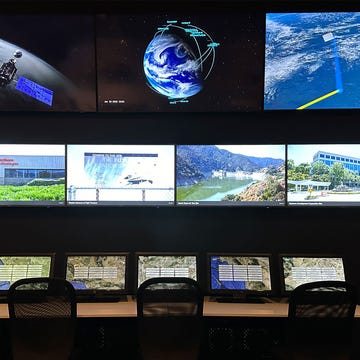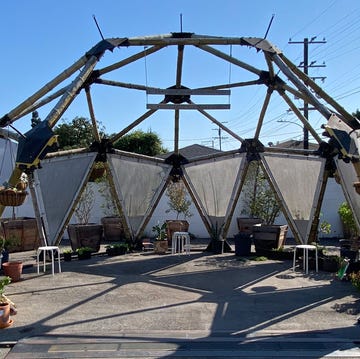Welcome to Alta Sketchbook, your guide to Getty’s PST Art: Art & Science Collide festival.
PST Art is the largest art event in the United States. Starting with today’s installment, Alta Sketchbook will offer the most intriguing takeaways from the 800-plus artists exploring the collision of art and science through exhibitions across Southern California.
Sign up for our weekly email to have our reviews and recommendations delivered straight to your inbox every Friday.
As Getty’s PST Art festival finally unfolds in earnest, its rich array of projects attempts to balance the energies of the studio with those of the laboratory. The group exhibition at Glendale’s Brand Library and Art Center, Blended Worlds: Experiments in Interplanetary Imagination, presents a series of interdisciplinary collaborations between artists and Jet Propulsion Laboratory’s design studio, a team of multidisciplinary developers working to translate NASA’s research into creative, accessible interpretations. JPL commissioned 11 artists to interact with the expertise and resources of NASA scientists and engineers. The result—a surprising, inventive, unsettling exhibition—explores alternate worlds and reimagines the one we already have, with the ultimate goal of figuring out how to merge them.
Artist David Bowen’s installation tele-present wind features plant stalks attached to tilting mechanical devices that move in response to wind data collected by NASA’s Perseverance rover on Mars. The work analyzes about a week’s worth of data on wind speed, air pressure, and other atmospheric elements. That information is then translated visually by the artist’s various gadgets that interpret how Martian weather would rustle reeds in a field. “When we started thinking about blended worlds, we started thinking about blending atmospheres,” says David Delgado, a JPL cultural strategist. “Bowen’s piece is seeing the presence of the Martian wind here on Earth.”
A Letter to the XO Planets, a suite of spherical sculptures by Bruce Mau, uses the globe as a tool to evaluate basic human beliefs. Why, Mau asks in his work, do we call our planet Earth when (from the numbers) it should be called Ocean? Another installation displays a metal piece of the Europa Clipper, a new NASA spacecraft that will explore the vast oceans thought to be beneath the surface of one of Jupiter’s moons. The vault plate, as it’s called, is engraved with an original poem by U.S. poet laureate Ada Limón titled “In Praise of Mystery: A Poem for Europa.” For now, Limón’s words are at the Brand Library, but soon they’ll be orbiting Earth aboard the Europa Clipper.
“We are creatures of constant awe, curious at beauty, at leaf and blossom, at grief and pleasure, sun and shadow,” Limón writes.
Back on terra firma—or at least the solidity of a tectonic plate—in a biographical short film, Burial of a Sense, cyborg artist Moon Ribas has special sensors implanted into her feet that receive constant real-time data on seismic activity, which in turn generates tremors in her body, informing her dance performances. The score to the film is her new work, Seismic Percussion, in which Ribas captures that same type of data from Earth and Mars and transcribes it into a musical drum score. Interested parties can watch a group of local students perform the score live at the Alex Theater on October 5.
And in a traditional, white-cube gallery room, Saskia Wilson-Brown, founder and executive director of Chinatown’s Institute for Art and Olfaction—a nonprofit dedicated to the study of scent—captures the smells of outer space in her work Sensory Mementos. The piece presents “a scenario where a future human, living off-planet, is trying to recreate the lost smells of his ancestors’ home on Earth,” Wilson-Brown says.
The installation features 24 scents inspired by Earth, like Pancake Breakfast and A Blade of Grass, and outer space—Rock Garden on Mars, The (Interstellar) Cloud, First Stop: The Moon. When it came to scents in space, Wilson-Brown's usual process was reversed—rather than re-create familiar scents by conventional perfumery methods, she used NASA research on the elemental and chemical compositions of “out there” and built unknown smells based on those findings. “Buzz Aldrin reported the dust on his and Armstrong’s spacesuits smelling like gunpowder or firecracker,” Wilson-Brown says.
She is still trying to bottle the smell of the cosmos.•
BLENDED WORLDS: EXPERIMENTS IN INTERPLANETARY IMAGINATION
Sept. 21, 2024–Jan. 4, 2025
Brand Library and Art Center
1601 W. Mountain St., Glendale
Shana’s Must-Sees
Small Paintings of Infinity
Artist James Griffith uses a proprietary tar-based pigment to paint evocative, moving, and Blakesian visionary works. The 21 images featured in this solo show simultaneously celebrate nature and cast an indictment on humans’ impact on the environment. Through Oct. 12, Craig Krull Gallery
Life on Earth: Art & Ecofeminism
The Brick (formerly LAXART) debuts its new building with a historically minded group show on ecofeminism and Indigenous philosophies in big, interactive mixed-media sculptural installations. Through Dec. 21, the Brick
Upcoming Exhibitions
Lightscape
Nov. 16, Los Angeles Philharmonic
Social Forest: Oaks of Tovaangar
Nov. 16, 2024–Apr. 6, 2025, the Broad
Digital Witness: Revolutions in Design, Photography, and Film
Nov. 24, 2024–July 13, 2025, Los Angeles County Museum of Art



















